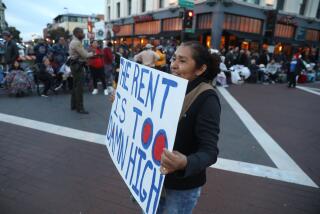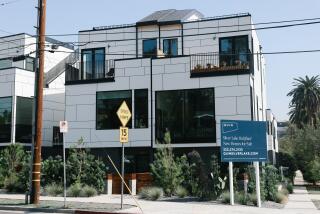Bail out homeowners, end the recession?
Today’s topic: Would a more effective stimulus have been a direct bailout for homeowners facing foreclosure?
The problem: There aren’t enough buyers
Point: Edward Leamer
It’s been 3 1/2 years since the housing market peaked at the end of 2005, and we are still nowhere close to normal. Exactly what should be done now is not at all clear. From 2002 to 2005, we happily drank the Kool-Aid mixture of high and rising home prices, high and rising rates of new home construction, and low and falling lending standards. The adjustment to those excesses has come with (surprise!) falling prices, falling building rates and rising lending standards. A symptom of those adjustments is painfully high and rising levels of foreclosures amplified by a high and rising unemployment rate. This is going to slow the recovery.
We have already made a lot of progress on the first two problems: too many homes with excessively high prices. At the bubble’s peak, housing starts were at the rate of 2.2 million per year. Using 1.6 million units as the normal annual rate of building, from 2001 until the end of 2006, we built 1.4 million more housing units than we needed.
But the subsequent under-building caused the stock of homes to hit normal levels this past May. At the current building rate of about 500,000 units a year, we are under-building by 1 million units, laying the foundation for the next housing mania. We need to get building rates back up soon.
According to the Federal Housing Finance Agency, home prices in the United States rose by 50% from the second quarter of 2001 to the second quarter of 2007. Through the second quarter of 2009, prices have fallen back by 10%. Is this enough? In answering this question, it is important to keep in mind that the fundamental force behind the rise in all asset prices during the bubble was a global glut of personal saving that drove down real interest rates to very low levels, which are still very much with us now that the 10-year Treasury bond is yielding only 3.5%.
While lower prices are part of the solution, they are also part of the problem. Our much-touted free-market system relies fundamentally on what economists call “downward sloping” demand curves: If the market price falls, sales rise. For homes this is not always the case. Lower prices create the hope and expectation of still lower prices later, and buyers often choose to wait it out to get the best deal. Falling prices cause tighter lending standards because of the elevated risk of default. Thus lower prices create lower sales, and we get overshooting in the downward direction. Clearly it is a good thing to intervene in this price-discovery process, but only if we knew exactly what the prices should be.
Last, we need to think about the lingering effects of incredibly low lending standards. First, I digress to vacancies. The number of vacant units waiting for buyers or renters is huge. Since the end of 2005, the number of housing units classified by the U.S. Census Bureau as “vacant” increased from 15.7 million to 18.7 million. The additional 3 million vacant homes is the equivalent of two normal years’ worth of new building.
How does this square with my assessment that the stock of homes returned to normal in May? One answer is that the recession is increasing the number of occupants per home, calling for programs that will encourage renters to buy. Another answer is that we built single-family homes in certain locations when what we needed were multifamily homes in other places. Greatly reduced lending standards allowed a large number of moderate-income Americans to buy homes in so-called exurbs, such as the far reaches of Southern California’s Inland Empire. The building that occurred there created homes for a class of buyers that no longer exists because the subprime mortgage market is gone for good. Going forward, these homes will find their best use as rental properties, rented to the very families who now occupy them as owners but don’t have the income to do the debt service. In these cases, we don’t want to stop the foreclosures. Instead, we should facilitate the change in status of the home from owner-occupant to rental, ideally rented to the same families who live there now.
I think it is very hard to design a fair and effective program that directly targets the foreclosure problem. What we have done so far isn’t doing the job. Economist Martin Feldstein’s idea for banks to voluntarily modify loans for troubled borrowers in exchange for recourse lending is intriguing, but the fundamental problem is that there aren’t enough buyers. With more buyers we could get stable and rising prices, which would allow lenders to loosen their tight lending standards and bring more buyers back into the market. Stable and rising prices would offer some hope to current owners that they could get back at least some of their investment, and they would be less likely to walk away from their homes.
Our government has been trying to bring buyers back with temporary tax incentives. President Obama’s $787-billion stimulus package includes a tax credit for first-time buyers of new or existing homes of 10% of the purchase price or $8,000, whichever is less, on sales that close before Dec. 1. But there are income limits that reduce the effectiveness of this program.
California has offered a tax credit of 10% of the purchase price or $10,000, whichever is less, to new home buyers regardless of income level for homes purchased between March 1, 2009, and March 1, 2010. But the $100-million fund for this program was exhausted in just four months and was used in fewer than 11,000 home transactions. This program is good for the builders, but not so good for the housing market because a new home buyer who is selling an older home is filling one vacancy but creating another.
Let’s hope these incentives are enough.
Edward Leamer, a UCLA economics and statistics professor, is director of the UCLA Anderson Forecast.
How Greenspan wanted the boom to go, and how it turned out
Counterpoint: Brad DeLong
Let me start by outlining how the 2000s were supposed to work -- according to former Federal Reserve Chairman Alan Greenspan.
The late 1990s had seen a large technology-led boom that had employed millions of Americans and provided a forced draft that intensified the fire of economic growth. It was accompanied by “irrational exuberance” in the venture capital and stock markets, as investors began to think not just that technological progress in information technology was rapid but that it would be easy for the companies they invested in to turn that technological progress into profits. The first half was true -- technological progress in America’s Silicon Valley is still ensuing at an extraordinary rate: I just got a spam e-mail offering to sell me a four-gigabyte USB flash disk for $9.25. In 1987, I paid $900 for a 10-megabyte hard disk.
But the second half -- that it would be easy to turn this progress into sustained profits -- turned out to be false. It’s very hard to pay a lot of dividends to your investors if you are selling four-gigabyte USB flash disks for $9.25.
In the early 2000s, investors began to realize that technological progress was easy relative to making profits in a competitive market, and stock prices for tech companies collapsed. The American high-tech industry began to shed workers as firms closed.
Greenspan decided to deal with this situation by lowering interest rates. The enormous flood of savings from Asia seeking investments in America had started, so low interest rates could be sustained because demand for funds would not outstrip supply. And low interest rates meant that lots of long-run durable investments would be profitable; you could, after all, borrow the money to produce or to buy them at low interest rates. The biggest long-run durable investment as a share of the American economy is housing. So Greenspan thought that he could keep unemployment low by generating a housing boom, so that as employment in tech companies (and related occupations) fell, employment in construction (and related occupations) would rise.
Did Greenspan worry about what would happen if the housing boom also succumbed to irrational exuberance? Yes. Did he worry very much? No. After all, when high-tech stocks and venture capital bubbles had collapsed, the systemwide consequences for the economy were small. Lots of over-enthusiastic investors lost their money -- but they were rich grown-ups, and the Federal Reserve doesn’t exist to keep rich people from risking their money in silly ways. Lots of engineers lost their jobs, but they had been well-paid during the boom and would not have had nearly as good jobs (or perhaps any jobs at all) were it not for the bubble. American consumers got a lot of cheap computers and a lot of extra fiber-optic cables over which to make our phone calls. The winners were American consumers and (during the boom) American workers. The losers were relatively rich American investors. Overall, it was a net plus.
Greenspan expected something similar to come out of the housing boom. If it did turn into a bubble, then the winners would be homeowners who bought houses on good terms by borrowing at low interest rates and renters who would find after the boom a plentiful supply of houses on the market and be able to bargain for big houses at cheap rents. The losers would be irrationally exuberant investors who had lent their money when it was cheap to borrow or bought expensive properties when prices were high. Once again -- Greenspan thought -- the boom as a whole, even with the likely magnitude of irrational exuberance and over-speculation, would be a net plus.
But it did not happen that way. The housing bust was big enough that, as you calculate, we are now back to having not a plentiful housing supply but rather one that is in line with historical trends. And we are still under-building, which you say is “laying the foundation for the next housing mania.” Yet because the bust triggered a financial crisis that triggered a recession, the construction industry is not seeing the kind of rising home values that trigger a recovery. Because of the recession, people are doubling up. And a great many houses are not where they should be -- four bedrooms with swimming pools east of San Bernardino, as you say, when what America really needs is multifamily units in northern Orange County. And you’re right, Ed.
Thus there is a strong case for government intervention in housing finance to try to get the construction sector back to where it ought to be. You point to California’s and the federal government’s respective tax credits for new home buyers and say that you hope they’re enough to turn the market around.
I don’t think they will be. I think we should face the fact that home mortgage finance is broken, that the risk tolerance of the private financial system is impaired and that we will not get the flow of finance to potential home buyers through private banks working again any time soon.
So I think -- I have thought for a year and a half now -- that it is time to bite the bullet. The federal government has already nationalized Fannie Mae and Freddie Mac. It should stop treating them like private companies and start treating them like arms of the Treasury. They should set an interest rate spread above the 30-year Treasury rate and then buy up every single mortgage and transform them into standard 30-year fixed-rate mortgages. The government may well lose money on the deal, but a lot of homeowners who cannot pay their current mortgages and are about to be foreclosed on could pay 30-year loans at a few percentage points above the Treasury rate.
A lot of construction companies would be willing to start building the multifamily units in northern Orange County that we need if they knew that potential condo buyers could get financing from the government on such terms.
And the government might, after all, make money on the deal.
Then, after the crisis is over, we can think about how to re-privatize the mortgage finance arm of the financial sector.
Brad DeLong is a UC Berkeley economics professor who served in the U.S. Treasury Department during the Clinton administration. His blog is “Grasping Reality with Both Hands.”
More to Read
A cure for the common opinion
Get thought-provoking perspectives with our weekly newsletter.
You may occasionally receive promotional content from the Los Angeles Times.






